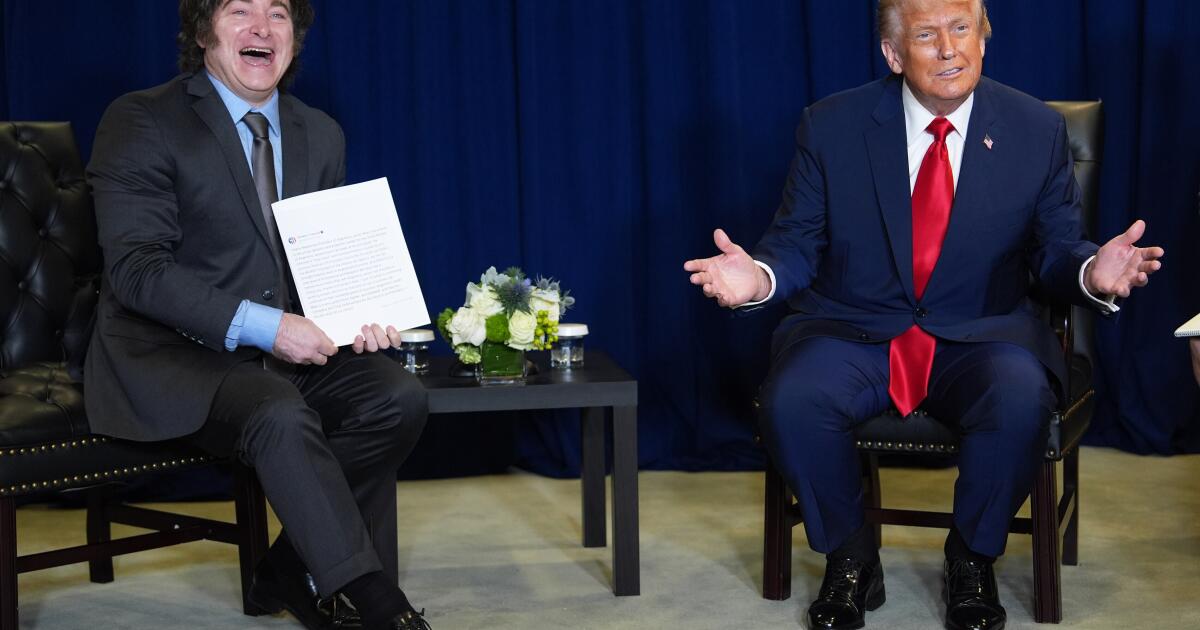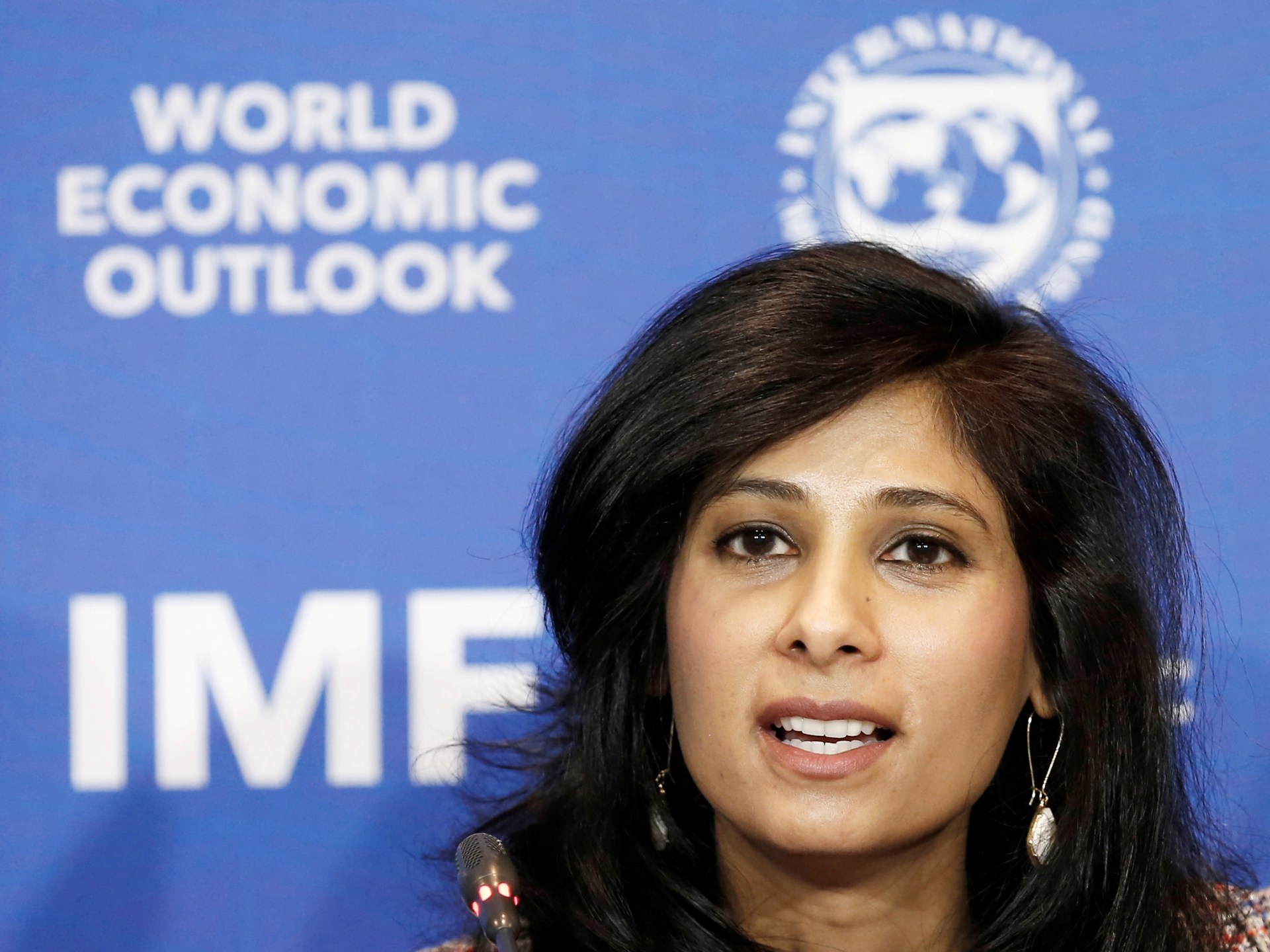Trump to welcome Argentina’s President Milei as U.S. extends $20 billion lifeline
BUENOS AIRES, Argentina — Argentina’s libertarian leader is lavishing praise on President Trump ahead of his first White House visit on Tuesday. It’s a tactic that has helped transform President Javier Milei ’s cash-strapped country into one of the Trump administration’s closest allies.
The effusive declarations are nothing new for Milei — whose dramatic cuts to state spending and attacks on “woke leftists” have won him a following among U.S. conservatives.
“Your commitment to life, freedom and peace has restored hope to the world,” Milei wrote on social media Monday, congratulating the U.S. president on securing a ceasefire deal in Gaza, where a truce is holding after a devastating, two-year Israel-Hamas war.
“It is an honor to consider you not only an ally in the defense of those values, but also a dear friend and an example of leadership that inspires all those who believe in freedom,” he said.
The Trump-Milei bromance has already paid off for Argentina — most recently, to the tune of a $20 billion bailout.
Experts say Milei comes to the White House with two clear objectives. One is to negotiate U.S. tariff exemptions or reductions for Argentine products.
The other is to see how the United States will implement a $20 billion currency swap line to prop up Argentina’s peso and replenish its depleted foreign currency reserves ahead of crucial midterm elections later this month.
In a crisis, turning to Trump
The Trump administration made a highly unusual decision to intervene in Argentina’s currency market after Milei’s party suffered a landslide loss in a local election last month.
Along with setbacks in the opposition-dominated Congress, the party’s crushing defeat created a crisis of confidence as voters in Buenos Aires Province registered their frustration with rising unemployment, contracting economic activity and brewing corruption scandals.
Alarmed that this could herald the end of popular support for Milei’s free-market program, investors dumped Argentine bonds and sold off the peso.
Argentina’s Treasury began hemorrhaging precious dollar reserves at a feverish pace, trying shore up the currency and keep its exchange rate within the trading band set as part of the country’s recent $20 billion deal with the International Monetary Fund.
But as the peso continued to slide, Milei grew desperate.
He met with Trump on Sept. 23 while in New York City for the United Nations General Assembly. A flurry of back-slapping, hand-shaking and mutual flattery between the two quickly gave way to U.S. Treasury Secretary Scott Bessent publicly promising Argentina a lifeline of $20 billion.
Markets cheered, and investors breathed a sigh of relief.
Timing is everything
In the days that followed, Argentine Economy Minister Luis Caputo spent hours in meetings in Washington trying to seal the deal.
Reassurance came last Thursday, when Bessent announced that the U.S. would allow Argentina to exchange up to $20 billion worth of pesos for an equal sum in dollars. Saying that the success of Milei’s program was “of systemic importance,” Bessent added that the U.S. Treasury directly purchased an unspecified amount of pesos.
For the Trump administration, the timing was awkward as it struggles to manage the optics of bailing out a nine-time serial defaulter in the middle of a U.S. government shutdown that has led to mass layoffs.
But for Argentina, it came in the nick of time.
Aware of how a weak currency could threaten his flagship achievement of taming inflation and hurt his popularity, Milei hopes to stave off what many economists see as an inescapable currency devaluation until after the the Oct. 26 midterm elections.
A devaluation of the peso would likely fuel a resurgence in inflation.
“Milei is going to the U.S. in a moment of desperation now,” said Marcelo J. García, political analyst and Director for the Americas at the Horizon Engage political risk consultancy firm.
“He needs to recreate market expectations and show that his program can be sustainable,” García added. “The government is trying to win some time to make it to the midterms without major course corrections, like devaluing or floating the peso.”
No strings attached
Milei was vague when pressed for details on his talks with Trump, expected later on Tuesday. Officials say he would have a two-hour meeting with the U.S. president, followed by a working lunch with other top officials.
He was also expected to participate in a ceremony at the White House honoring Charlie Kirk, the prominent right-wing political activist who was fatally shot last month. Milei often crossed paths with Kirk on the speaking circuit of the ascendant global right.
“We don’t have a single-issue agenda, but rather a multi-issue agenda,” Milei told El Observador radio in Buenos Aires Monday. “Things that are already finalized will be announced, and things that still need to be finalized will remain pending.”
It’s not clear what strings, if any, the Trump administration has attached to the currency swap deal, which Democratic lawmakers and other critics have slammed as an example of Trump rewarding loyalists at the expense of American taxpayers.
There has been no word on how Argentina, the IMF’s largest debtor, will end up paying the U.S. back for this $20 billion, which comes on top of IMF’s own loan for the same amount in April. And that one came on top of an earlier IMF loan for $40 billion.
Despite all the help, Milei’s government already missed the IMF’s early targets for rebuilding currency reserves.
“The U.S. should be concerned that Argentina has had to return for $20 billion so quickly after getting $14 billion upfront from the IMF,” said Brad Setser, a former Treasury official now at the Council on Foreign Relations.
“I worry that this may prove to just be a short-term bridge and won’t leave Argentina better equipped” to tackle its problems, he added.
But in the radio interview before his flight, Milei was upbeat. He gushed about U.S. support saving Argentina from “the local franchise of 21st-century socialism” and waxed poetic about Argentina’s economic potential.
“There will be an avalanche of dollars,” Milei said. “We’ll have dollars pouring out of our ears.”
Debre writes for the Associated Press.


